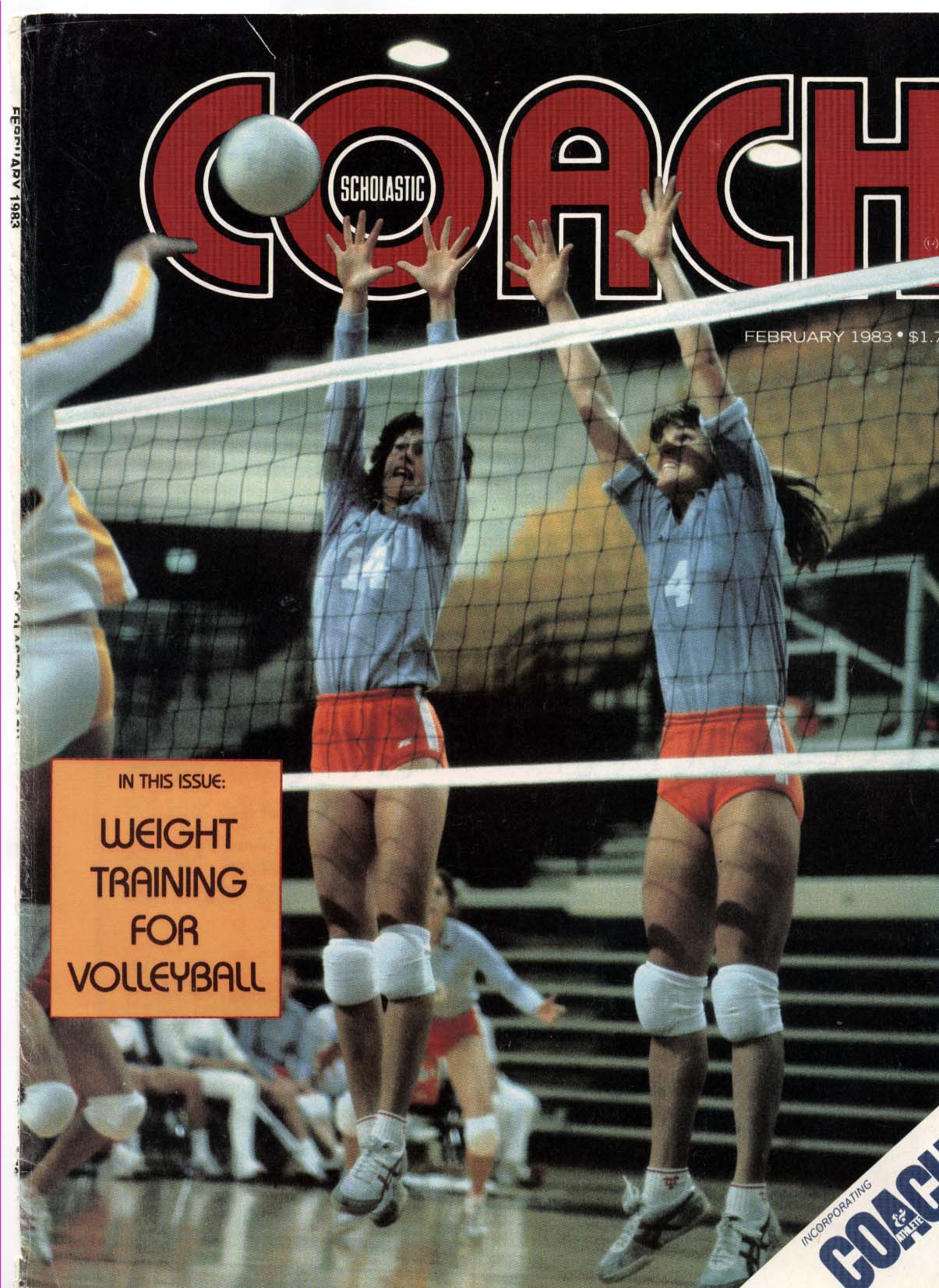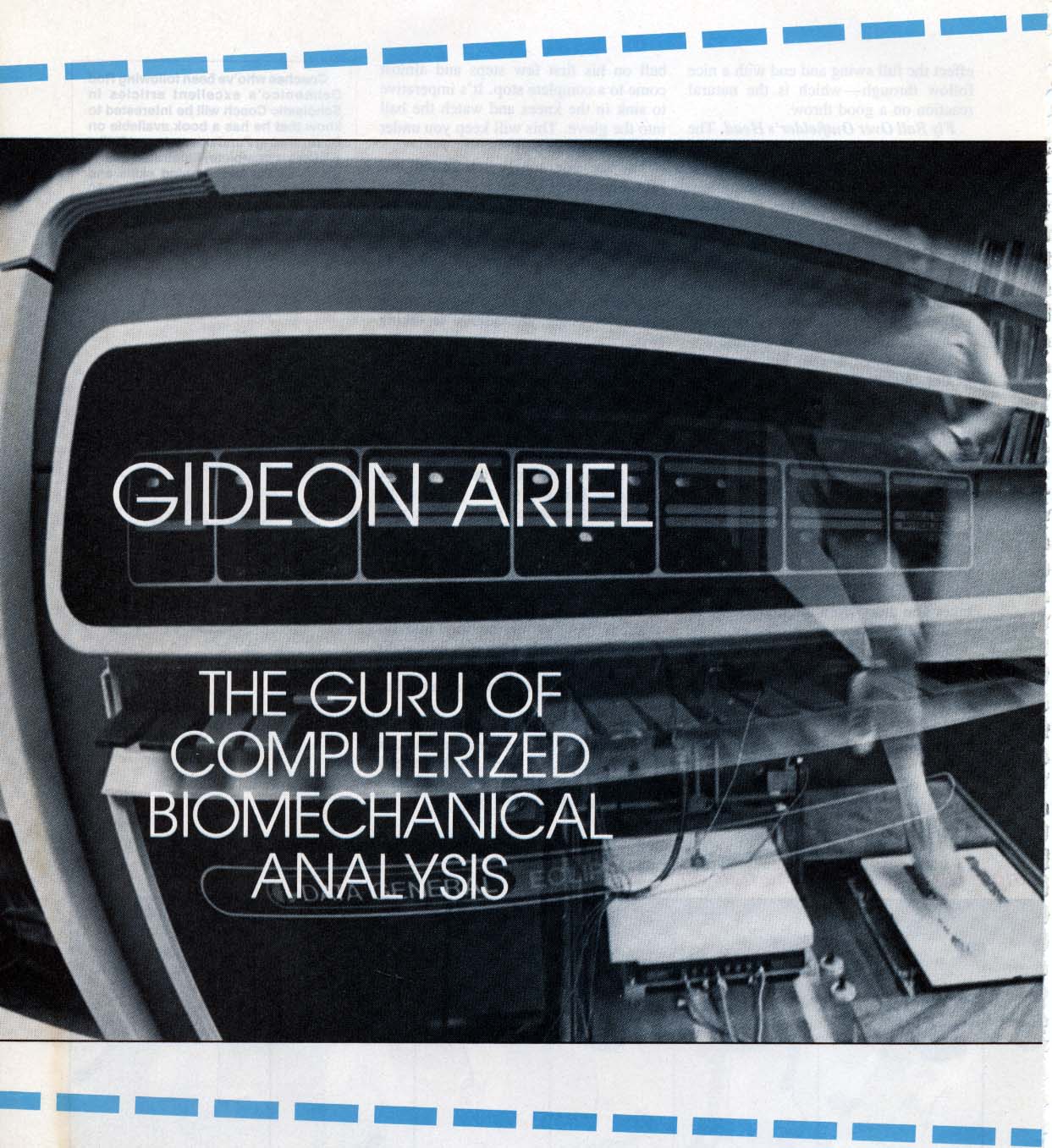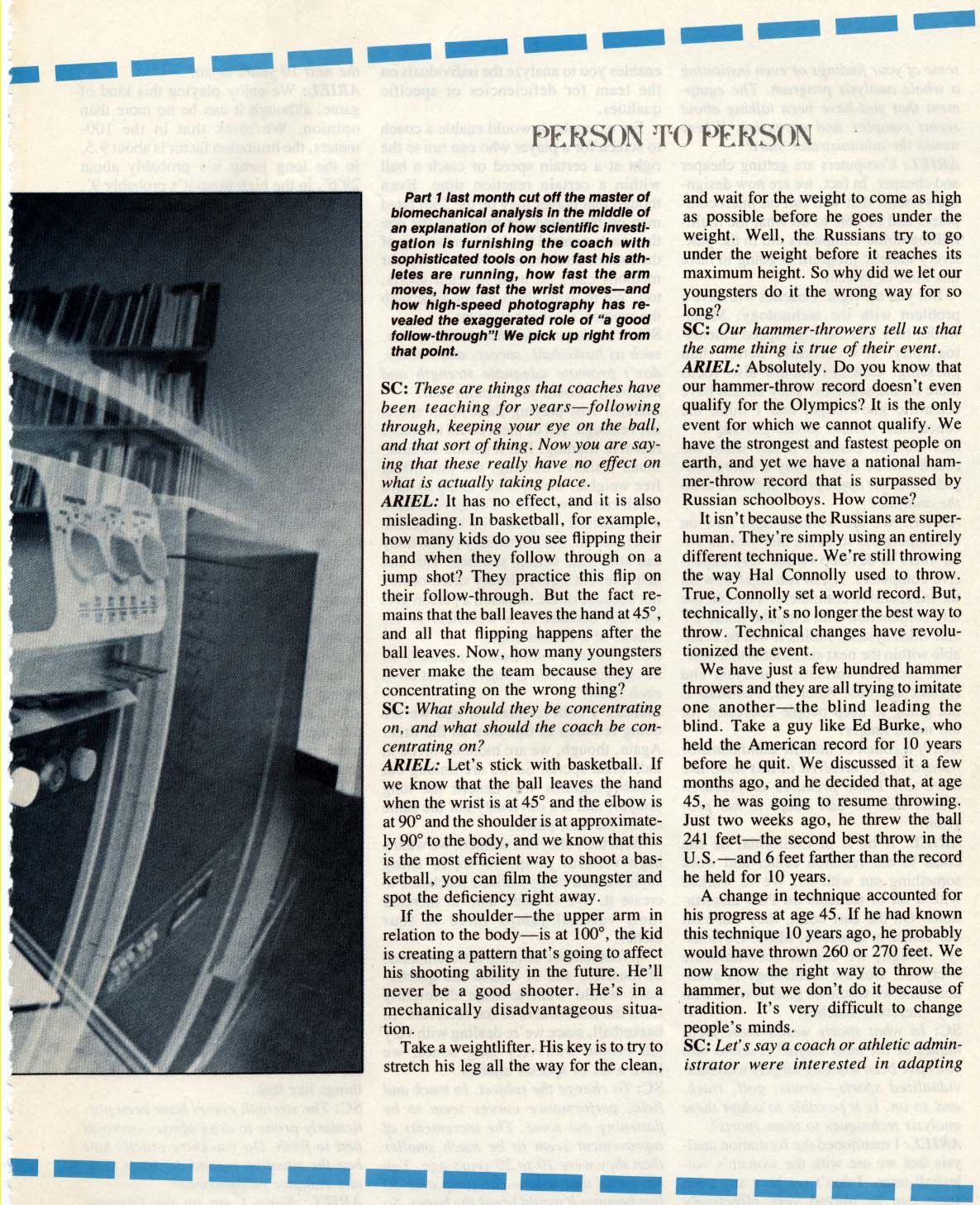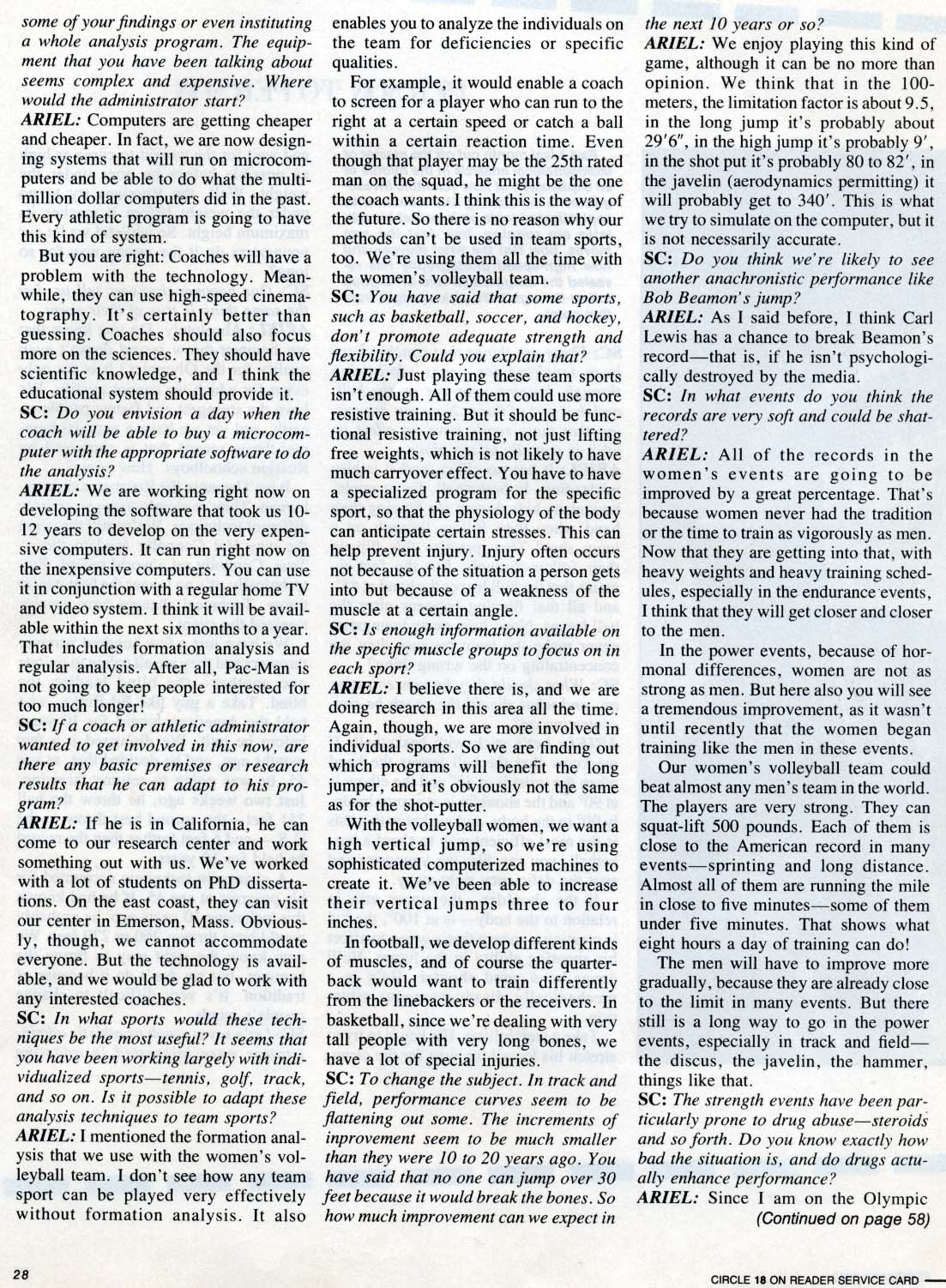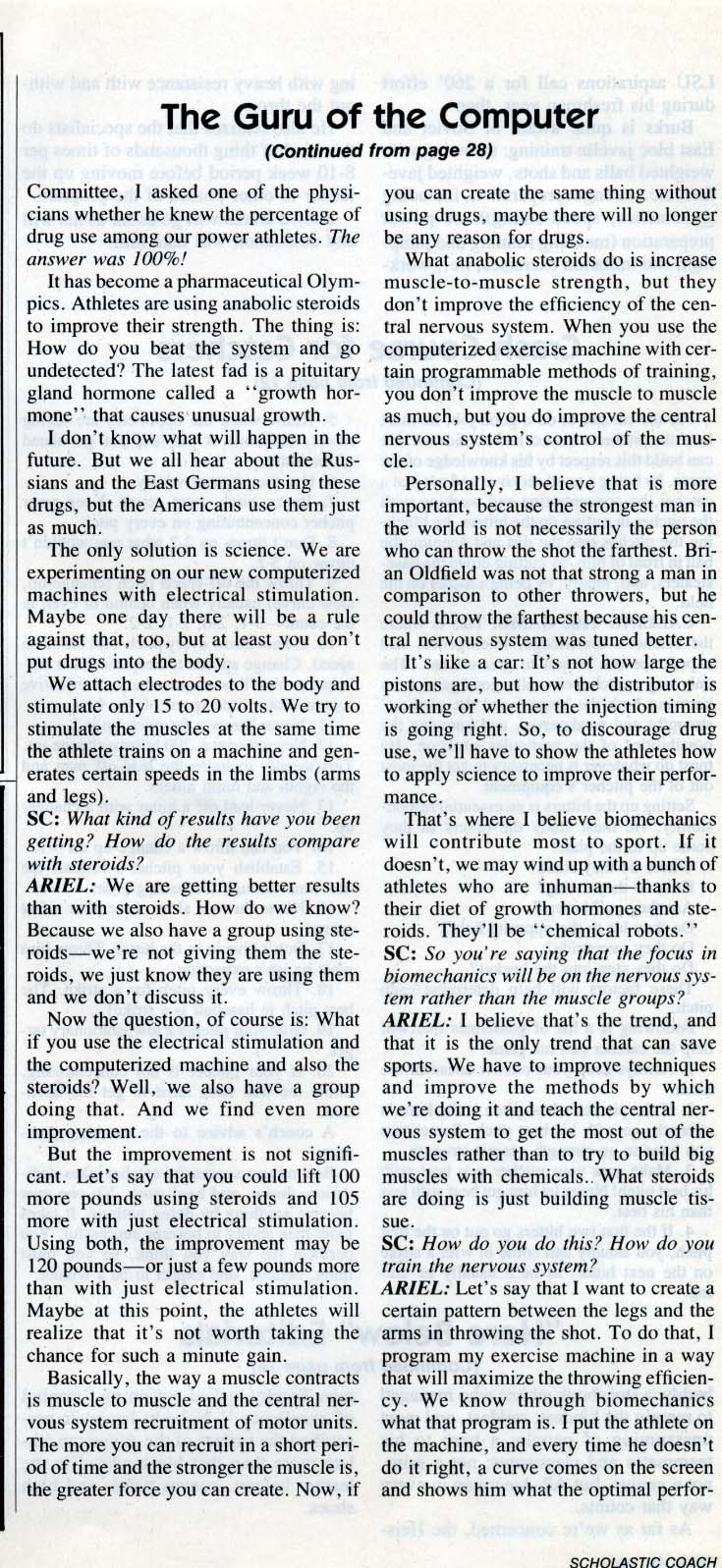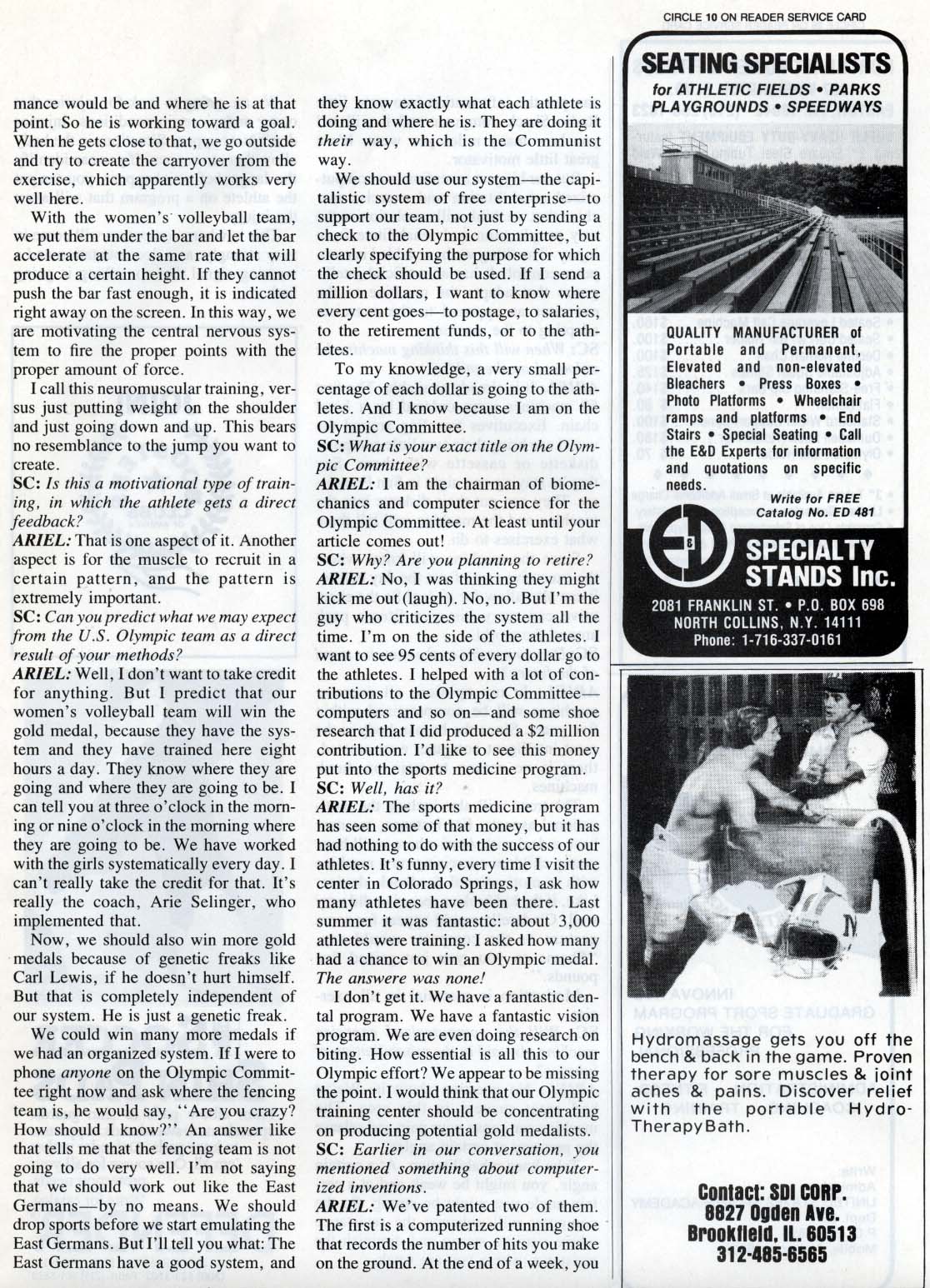Gideon Ariel, The Guru of Computerized Biomechanical Analysis
The Master of Biomechanics in Action
By Unknown in Scholastic Coach on Tuesday, February 1, 1983
Biomechanics and Sports Performance: A Conversation with Ariel
This article features an interview with Ariel, a master of biomechanical analysis, discussing how scientific investigation is providing coaches with sophisticated tools to enhance athletes' performance. Ariel argues that traditional coaching techniques, such as emphasizing follow-through in basketball, are often misleading and ineffective. Instead, he suggests that coaches should focus on biomechanics, such as the optimal angles for shooting a basketball. Ariel also discusses the potential of computerized analysis and training systems, which he believes will become commonplace in athletic programs. He highlights the importance of coaches having a scientific understanding of sports performance and believes that this knowledge should be provided by the educational system. Ariel also discusses the potential of using electrical stimulation in training, which he believes could yield better results than anabolic steroids. He concludes by emphasizing the importance of focusing on the nervous system rather than muscle groups in biomechanics and training.
The article discusses a new computerized rehabilitation and exercise machine that is expected to revolutionize the way people train and rehabilitate from injuries. The machine, which is already available, uses artificial intelligence to adapt to the exerciser, rather than the other way around. It can be programmed with a user's specific exercise routine and can even account for factors like jet lag. The machine is also designed to aid in injury rehabilitation, as it can sense pain and adjust resistance accordingly. The article suggests that all exercise machines will be computerized within five years, as the human body is the most intelligent computer ever created.
Tip: use the left and right arrow keys
PERSON TO PER SON,
Part 1 last month cut off the master of biomechanical analysis in the middle of an explanation of how scientific Investigation is furnishing the coach with sophisticated tools on how fast his athletes are running, how fast the arm moves, how fast the wrist moves-and how high-speed photography has revealed the exaggerated role of "a good
follow-through"! We pick up right from
that point.
SC: These are things that coaches have been teaching for years following through, keeping your eye on the ball. and that sort of thing. Now you are saying that these really have no effect on what is actually taking place.
ARIEL: It has no effect, and it is also misleading. In basketball, for example, how many kids do you see flipping their hand when they follow through on a jump shot'? They practice this flip on their follow-through. But the fact remains that the ball leaves the hand at 45�, and all that flipping happens after the ball leaves. Now, how many youngsters never make the team because they are concentrating on the wrong thing'? SC: What should they be concentrating on, and what should the coach be concentrating on?
ARIEL: Let's stick with basketball. If we know that the ball leaves the hand when the wrist is at 45� and the elbow is at 90� and the shoulder is at approximately 90� to the body, and we know that this is the most efficient way to shoot a basketball, you can film the youngster and spot the deficiency right away.
If the shoulder-the upper arm in relation to the body-is at 100�, the kid is creating a pattern that's going to affect his shooting ability in the future. He'll never be a good shooter. He's in a mechanically disadvantageous situation.
Take a weightlifter. His key is to try to stretch his leg all the way for the clean,
and wait for the weight to come as high as possible before he goes under the weight. Well, the Russians try to go under the weight before it reaches its maximum height. So why did we let our youngsters do it the wrong way for so long?
SC: Our hammer-throwers tell us that the same thing is true of their event. ARIEL: Absolutely. Do you know that our hammer-throw record doesn't even qualify for the Olympics? It is the only event for which we cannot qualify. We have the strongest and fastest people on earth, and yet we have a national hammer-throw record that is surpassed by Russian schoolboys. How come'?
It isn't because the Russians are superhuman. They're simply using an entirely different technique. We're still throwing the way Hal Connolly used to throw. True, Connolly set a world record. But, technically, it's no longer the best way to throw. Technical changes have revolutionized the event.
We have just a few hundred hammer throwers and they are all trying to imitate one another-the blind leading the blind. Take a guy like Ed Burke, who held the American record for 10 years before he quit. We discussed it a few months ago, and he decided that, at age 45, he was going to resume throwing. Just two weeks ago, he threw the ball 241 feet-the second best throw in the U.S.-and 6 feet farther than the record he held for 10 years.
A change in technique accounted for his progress at age 45. If he had known this technique 10 years ago, he probably would have thrown 260 or 270 feet. We now know the right way to throw the hammer, but we don't do it because of tradition. It's very difficult to change people's minds.
SC: Let's say a coach or athletic administrator were interested in adapting
M
some of your findings or even instituting a whole analysis program. The equipment that you have been talking about seems complex and expensive. Where would the administrator start?
ARIEL: Computers are getting cheaper and cheaper. In fact, we are now designing systems that will run on microcomputers and he able to do what the multimillion dollar computers did in the past. Every athletic program is going to have this kind of system.
But you are right: Coaches will have a problem with the technology. Meanwhile, they can use high-speed cinematography. It's certainly better than guessing. Coaches should also focus more on the sciences. They should have scientific knowledge. and I think the educational system should provide it. SC: Do you envision a day when the coach will be able to buy a microcomputer with the appropriate software to do the analysis?
ARIEL: We are working right now on developing the software that took us 1012 years to develop on the very expensive computers. It can run right now on the inexpensive computers. You can use it in conjunction with a regular home TV and video system. I think it will be available within the next six months to a year. That includes formation analysis and regular analysis. After all, Pac-Man is not going to keep people interested for too much longer!
SC: if a coach or athletic administrator wanted to get involved in this now, are there any basic premises or research results that he can adapt to his program?
ARIEL: If he is in California. he can come to our research center and work something out with us. We've worked with a lot of students on PhD dissertations. On the east coast, they can visit our center in Emerson, Mass. Obviously, though, we cannot accommodate everyone. But the technology is available, and we would he glad to work with any interested coaches.
SC: In what sports would these techniques be the most useful? It seems that you have been working largely with individualized sports-tennis, golf. track, and so on. Is it possible to adapt these analysis techniques to team sports? ARIEL: I mentioned the formation analysis that we use with the women's volleyball team. I don't see how any team sport can he played very effectively without formation analysis. It also
enables you to analyze the individuals on the team for deficiencies or specific qualities.
For example, it would enable a coach to screen for a player who can run to the right at a certain speed or catch a ball within a certain reaction time. Even though that player may be the 25th rated man on the squad, he might he the one the coach wants. I think this is the way of the future. So there is no reason why our methods can't be used in team sports, too. We're using them all the time with the women's volleyball team. SC: You have said that some sports. such as basketball, soccer, and hockey, don't promote adequate strength and flexibility. Could you explain that? ARIEL: Just playing these team sports isn't enough. All of them could use more resistive training. But it should be functional resistive training, not just lifting free weights, which is not likely to have much carryover effect. You have to have a specialized program for the specific sport, so that the physiology of the body can anticipate certain stresses. This can help prevent injury. Injury often occurs not because of the situation a person gets into but because of a weakness of the muscle at a certain angle. SC: is enough information available on the specific muscle groups to focus on in each sport?
ARIEL: I believe there is, and we are doing research in this area all the time. Again, though, we are more involved in individual sports. So we are finding out which programs will benefit the long jumper, and it's obviously not the same as for the shot-putter.
With the volleyball women, we want a high vertical jump, so we're using sophisticated computerized machines to create it. We've been able to increase their vertical jumps three to four inches.
In football, we develop different kinds of muscles, and of course the quarterback would want to train differently from the linebackers or the receivers. In basketball, since we're dealing with very tall people with very long bones, we have a lot of special injuries. SC: To change the subject. In track and field, performance curves seem to be flattening out some. The increments of inprovement seem to be much smaller than they were 10 to 20 years ago. You have said that no one can jump over 30 feet because it would break the hones. So how much improvement can we expect in
the next 10 years or so?
ARIEL: We enjoy playing this kind of game, although it can be no more than opinion. We think that in the 100meters, the limitation factor is about 9.5, in the long jump it's probably about 29'6" in the high jump it's probably 9'. in the shot put it's probably 80 to 82', in the javelin (aerodynamics permitting) it will probably get to 340'. This is what we try to simulate on the computer, but it is not necessarily accurate. SC: Do you think we're likely to see another anachronistic performance like Bob Beamon's jump? ARIEL: As I said before, I think Carl Lewis has a chance to break Beamon's record-that is. if he isn't psychologically destroyed by the media. SC: in what events do you think the records are very soft and could be shattered'
ARIEL: All of the records in the women's events are going to be improved by a great percentage. That's because women never had the tradition or the time to train as vigorously as men. Now that they are getting into that, with heavy weights and heavy training schedules. especially in the endurance events. I think that they will get closer and closer to the men.
In the power events, because of hormonal differences, women are not as strong as men. But here also you will see a tremendous improvement, as it wasn't until recently that the women began training like the men in these events.
Our women's volleyball team could beat almost any men's team in the world. The players are very strong. They can squat-lift 500 pounds. Each of them is close to the American record in many events-sprinting and long distance. Almost all of them are running the mile in close to five minutes-some of them under five minutes. That shows what eight hours a day of training can do!
The men will have to improve more gradually, because they are already close to the limit in many events. But there still is a long way to go in the power events, especially in track and fieldthe discus, the javelin, the hammer. things like that.
SC: The strength events have been particularly prone to drug abuse-steroids and so forth. Do you knob exactly how bad the situation is, and do drugs actually enhance performance?
ARIEL: Since I am on the Olympic
(Continued on page 58)
28
CIRCLE 1$ ON READER SERVICE CARD -
The Guru of the Computer
(Continued from page 28)
Committee, I asked one of the physicians whether he knew the percentage of drug use among our power athletes. The answer was 100%!
It has become a pharmaceutical Olympics. Athletes are using anabolic steroids to improve their strength. The thing is: How do you beat the system and go undetected'? The latest fad is a pituitary gland hormone called a "growth hormone" that causes unusual growth.
I don't know what will happen in the future. But we all hear about the Russians and the East Germans using these drugs, but the Americans use them just as much.
The only solution is science. We are experimenting on our new computerized machines with electrical stimulation. Maybe one day there will be a rule against that, too, but at least you don't put drugs into the body.
We attach electrodes to the body and stimulate only 15 to 20 volts. We try to stimulate the muscles at the same time the athlete trains on a machine and generates certain speeds in the limbs (arms and legs).
SC: What kind of results have you been getting? How do the results compare with steroids?
ARIEL: We are getting better results than with steroids. How do we know? Because we also have a group using steroids-we're not giving them the steroids, we just know they are using them and we don't discuss it.
Now the question. of course is: What if you use the electrical stimulation and the computerized machine and also the steroids'? Well, we also have a group doing that. And we find even more improvement.
But the improvement is not significant. Let's say that you could lift 100 more pounds using steroids and 105 more with just electrical stimulation. Using both, the improvement may be 120 pounds-or just a few pounds more than with just electrical stimulation. Maybe at this point, the athletes will realize that it's not worth taking the chance for such a minute gain.
Basically, the way a muscle contracts is muscle to muscle and the central nervous system recruitment of motor units. The more you can recruit in a short period of time and the stronger the muscle is, the greater force you can create. Now, if
you can create the same thing without using drugs, maybe there will no longer be any reason for drugs.
What anabolic steroids do is increase muscle-to-muscle strength, but they don't improve the efficiency of the central nervous system. When you use the computerized exercise machine with certain programmable methods of training, you don't improve the muscle to muscle as much, but you do improve the central nervous system's control of the muscle.
Personally, I believe that is more important, because the strongest man in the world is not necessarily the person who can throw the shot the farthest. Brian Oldfield was not that strong a man in comparison to other throwers, but he could throw the farthest because his central nervous system was tuned better.
It's like a car: It's not how large the pistons are, but how the distributor is working or whether the injection timing is going right. So. to discourage drug use, we'll have to show the athletes how to apply science to improve their performance.
That's where 1 believe biomechanics will contribute most to sport. If it doesn't, we may wind up with a bunch of athletes who are inhuman-thanks to their diet of growth hormones and steroids. They'll be "chemical robots." SC: So you're saving that the focus in biomechanics will be on the nervous system rather than the muscle groups? ARIEL: I believe that's the trend, and that it is the only trend that can save sports. We have to improve techniques and improve the methods by which we're doing it and teach the central nervous system to get the most out of the muscles rather than to try to build big muscles with chemicals.. What steroids are doing is just building muscle tissue.
SC: How do you du this? How do you train the nervous system?
ARIEL: Let's say that I want to create a certain pattern between the legs and the arms in throwing the shot. To do that, I program my exercise machine in a way that will maximize the throwing efficiency. We know through biomechanics what that program is. I put the athlete on the machine, and every time he doesn't do it right, a curve comes on the screen and shows him what the optimal perfor
SCHOLASTIC COACH
CIRCLE 10 ON READER SERVICE CARD
mance would be and where he is at that point. So he is working toward a goal. When he gets close to that, we go outside and try to create the carryover from the exercise, which apparently works very well here.
With the women's volleyball team, we put them under the bar and let the bar accelerate at the same rate that will produce a certain height. If they cannot push the bar fast enough, it is indicated right away on the screen. In this way, we are motivating the central nervous system to fire the proper points with the proper amount of force.
I call this neuromuscular training, versus just putting weight on the shoulder and just going down and up. This bears no resemblance to the jump you want to create.
SC: Is this a motivational type of training, in which the athlete gets a direct feedback
ARIEL: That is one aspect of it. Another aspect is for the muscle to recruit in a certain pattern, and the pattern is extremely important.
SC: Can you predict what we may expect from the U.S. Olympic team as a direct result of your methods?
ARIEL: Well, I don't want to take credit for anything. But 1 predict that our women's volleyball team will win the gold medal, because they have the system and they have trained here eight hours a day. They know where they are going and where they are going to be. I can tell you at three o'clock in the morning or nine o'clock in the morning where they are going to be. We have worked with the girls systematically every day. I can't really take the credit for that. It's really the coach, Arie Selinger. who implemented that.
Now, we should also win more gold medals because of genetic freaks like Carl Lewis, if he doesn't hurt himself. But that is completely independent of our system. He is just a genetic freak.
We could win many more medals if we had an organized system. If I were to phone anyone on the Olympic Committee right now and ask where the fencing team is, he would say. "Are you crazy? How should I know?" An answer like that tells me that the fencing team is not going to do very well. I'm not saying that we should work out like the East Germans-by no means. We should drop sports before we start emulating the East Germans. But I'll tell you what: The East Germans have a good system, and
they know exactly what each athlete is doing and where he is. They are doing it their way, which is the Communist way.
We should use our system-the capitalistic system of free enterprise-to support our team, not just by sending a check to the Olympic Committee, but clearly specifying the purpose for which the check should be used. If I send a million dollars, I want to know where every cent goes-to postage, to salaries, to the retirement funds, or to the athletes.
To my knowledge, a very small percentage of each dollar is going to the athletes. And I know because I am on the Olympic Committee.
SC: What is your exact title on the Olympic Committee?
ARIEL: I am the chairman of biomechanics and computer science for the Olympic Committee. At least until your article comes out!
SC: Why? Are you planning to retire?
ARIEL: No, I was thinking they might kick me out (laugh). No, no. But I'm the guy who criticizes the system all the time. I'm on the side of the athletes. I want to see 95 cents of every dollar go to the athletes. 1 helped with a lot of contributions to the Olympic Committeecomputers and so on-and some shoe research that I did produced a $2 million contribution. I'd like to see this money put into the sports medicine program.
SC: Well, has it?
ARIEL: The sports medicine program has seen some of that money, but it has had nothing to do with the success of our athletes. It's funny. every time I visit the center in Colorado Springs. I ask how many athletes have been there. Last summer it was fantastic: about 3,000 athletes were training. I asked how many had a chance to win an Olympic medal.
The answere was none!
I don't get it. We have a fantastic dental program. We have a fantastic vision program. We are even doing research on biting. How essential is all this to our Olympic effort? We appear to be missing the point. 1 would think that our Olympic training center should be concentrating on producing potential gold medalists.
SC: Earlier in our conversation. You mentioned something about computerized inventions.
ARIEL: We've patented two of them. The first is a computerized running shoe that records the number of hits you make on the ground. At the end of a week, you
SEATING SPECIALISTS
for ATHLETIC FIELDS � PARKS
PLAYGROUNDS � SPEEDWAYS
SPECIALTY STANDS Inc.
2081 FRANKLIN ST. � P.O. BOX 698
NORTH COLLINS, N.Y. 14111
Phone: 1-716-337-0161
Hydromassage gets you off the bench & back in the game. Proven therapy for sore muscles & joint aches & pains. Discover relief with the portable HydroTherapy Bath.
Contact: 301 CORP.
8827 Ogden Ave.
Brooklleld, IL. 60513
312.485.6565
"h144,
h
00
QUALITY MANUFACTURER of Portable and Permanent, Elevated and non-elevated Bleachers � Press Boxes Photo Platforms � Wheelchair ramps and platforms � End Stairs � Special Seating � Call the END Experts for information and quotations on specific needs.
Write for FREE
Catalog No. ED 481
can put the information into your little Radio Shack computer and it will tell you how many miles you went. It's a great little motivator.
But our biggest invention is a computerized rehabilitation and exercise machine that we think will revolutionize the way people train and rehabilitate from injury. The thing we have added is computer-control. It has an artificial intelligence that adapts the machine to the exerciser as opposed to the exerciser adapting to the machine.
SC: When will this thinking machine he unloosed on the public?
ARIEL: It is already available. The first 50 machines were ordered by a hotel chain. Executives traveling around the world can bring their own little computer diskette or cassette with them. Say they're staying one night in San Francisco. They can put their diskette into the machine and the machine will tell them what exercises to do.
Since the machine will know where the executive came from the day before, it can also allow for jet lag! So the executive can carry his own fitness pack around the world.
SC: Do you see this as the exercise trend gf'the figure?
ARIEL: In my opinion, all exercise machines will be computerized within five years. Since the human body is the most intelligent computer ever created, there is no reason to train on dumb machines.
The trend will also include the motivational aspects. For instance, we now have a deal with Atari where we'll have young children exercising on a machine with a motivational feedback device. Like, if the kid broke a record or did very well, Cinderella would appear for some gesture or the computer would say, "Shame on you, you just gained five pounds."
Motivation is essential in all exercise.
SC: Will the computerized exercise machine also aid in the rehabilitation of injuries.'
ARIEL: No question about it. We've had great success in this area. The machine can sense your pain and release the pressure at certain angles.
Take knee rehabilitation. At a certain angle, you might he weak and at a certain angle you might be strong. So the computer will enhance the resistance where you are strong and diminish the resistance where you are weak.
We are going to look for injuries that occur under certain conditions. Injuries don't just happen. Situations in the body allow them to happen. If you can identify the danger before it happens, you can put the athlete on a program that will avert the injury.
This is where computers will come in very strongly: as a documentation and a warning signal that something is going bad.

